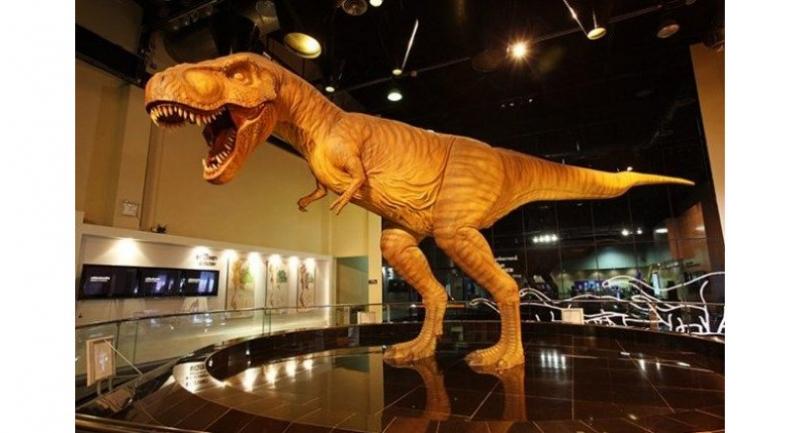Dinosaurs take families off the beaten track in Isan

Phu Wiang National Park is like many other dinosaur-related travel sites around Thailand. It is weird, wonderful and wacky, located well and truly off-the-beaten track, or the so-called ‘tourist trail’, hundreds of miles away from Bangkok in Thailand’s Northeast region of Isan.
All around Isan, visitors are likely to find huge dinosaur models in parks, zoos or alongside temples. Dinosaurs even decorate the tops of some public lamp posts as a shout out to the region’s ‘big lizard’ claim to fame.
Khon Kaen province is well known for dinosaurs, and particularly the Phu Wiang mountains where several important paleontological discoveries have been made, including two previously unknown species: ‘Phuwiangosaurus Sirindhornae’, a 15-metre (49 feet) long sauropod named after Thailand’s beloved Princess, Her Royal Highness Princess Maha Chakri Sirindhorn, and ‘Siamotyrannus Isanensis’, an ancestor of Tyrannosaurus Rex named after Thailand and Isan.
Exploring the Phu Wiang National Park attractions, kids can discover completely new dinosaur species they might never have even heard of before. The Park covers an area of over 380 sq km, so there is a lot of ground to explore. Several unique species indigenous to Thailand have been discovered at the National Park and around other sites in and around Khon Kaen province, which is why many consider it the dinosaur capital of Thailand. Visitors will find fossil digs, bones and models in its museums and current active dig sites around the park.
‘Siamotyrannus’ is the Thai version of a Tyrannosaurus Rex and looks kind of like a cross between a T-Rex and a crocodile. It stands upright, but it’s got a crocodile head, and it waded in shallow water looking for prey.
The huge plant-eating long-necked Phuwiangosaurus, also discovered in Phu Wiang, is considered a sauropod, as scientists now more commonly refer to it. In many sites, geologists have found fossils of infant dinosaurs, small crocodiles and mussels dating back more than 150 million years.
Sirindhorn Dinosaur Museum goes international
The Sirindhorn Dinosaur Museum became Thailand’s first dinosaur fossil museum when it opened in 1995, while the Fukui Prefectural Dinosaur Museum opened in 2000 and is generally considered one of the world’s three great dinosaur museums, along with the Royal Tyrrell Museum of Palaeontology in Canada and the Zigong Dinosaur Museum in China.
Also located in Isan in Kalasin, Northeast Thailand, the Sirindhorn Museum is now part of a partnership between Thailand and Japan and the two countries’ best-known dinosaur museums. The Sirindhorn Dinosaur Museum and the Fukui Prefectural Dinosaur Museum, located in the Chubu region of Japan, are now ‘sister museums’ in a move expected to facilitate joint studies, research projects, fossil preservation and the development of geological tourism between the countries. The agreement was initiated when the Fukui PDM borrowed fossil samples from the Sirindhorn Dinosaur Museum for a special display in Japan.
Si Wiang Dinosaur Park
The Si Wiang Dinosaur Park is another well-known tourist attraction of Khon Kaen province that first welcomed visitors in 2007. The Park features various spots for relaxation including a health garden, waterfall, pond, playground and over one hundred statues of dinosaurs; some of which are animatronic that move and make sounds like real dinosaurs once a coin is inserted into the machine. These statues are representative of the fossilised dinosaurs discovered around Isan.
It is even further off-the-beaten track on the road leading to the Phu Wiang National Park from Khon Kaen town.
When dinosaurs roamed Isan
When dinosaurs walked the earth, they left big footprints wherever they trod. Physical evidence of this is prevalent around Isan, with massive dinosaur footprints at the Phu Faek Forest Park in Kalasin. As the story goes, a family noticed strange footprints in the middle of a rock terrace back in November 1996. They later informed Thai geologists who came to survey the site. They discovered 21 footprints in total, belonging to carnivorous dinosaurs, believed to have lived in the area 140 million years ago. At present, only four footprints can be clearly accessed by the public.
The Dinosaur Footprint Park in Nakhon Phanom province features footprints imprinted into the region’s reddish-brown sandstone approximately 100 million years ago, and later confirmed by Thai palaeontologists as footprints of theropods and ornithopods.
Dinosaur excursions make for outstanding day trips in Thailand, which around Khon Kaen province also offers awesome views of the circular Phu Wiang Mountains as a dramatic backdrop. It makes for a great day out with family or friends, or offers an adventure for travellers who seek Thai local experiences that date to when dinosaurs roamed Isan, and pretty much every other place on Earth.
